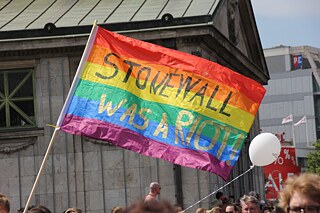At Pride parades around the world, queer people celebrate diverse gender identities and sexual orientations and demand equal rights for everyone, especially big in Washington, D.C. this year. But where does this tradition come from?
The Birth of a Movement
At the Stonewall Inn, a bar in Lower Manhattan, the modern LGBTQIA+ movement first saw the light of day in the midsummer of 1969. Suppressed by discriminatory laws and persecuted by state violence, the queer community often had no choice but to retreat into private and sometimes illegal spaces. Police raids were no rarity. But the brutality with which state forces proceeded at the Stonewall Inn on Christopher Street in New York City prompted the guests of the queer bar to fight back. The battles in the streets lasted for days and sent a signal of resistance to peers in the USA and beyond – up to the present day.
The Stonewall Inn has become a place for commemoration for members and allies of the queer community. Pictured are decorations that were placed in condolence for those killed during a mass shooting in a gay nightclub in Florida.
|
Rhododendrites, CC BY-SA 4.0
For many people, pride parades are a safe space. Surrounded by like-minded people and free from hostility, queers can celebrate: “Pride is a chance to celebrate and really be proud of who you are and who we are, no apologies”, say Roman and Richard Baran from New York, who have been married since 2012. For many, however, it is more than that – the phrase ‘Stonewall was a Riot’ can be read again and again on signs or rainbow flags. It is a reminder that equal rights and the recognition of their identities had to be fought for against massive resistance.

"Stonewall was a Riot" on a rainbow flag at Christopher Street Day in Berlin 2018 | Sven Volkens, CC BY-SA 4.0, via Wikimedia Commons
For many younger members of the queer community, a key issue will have been same-sex marriage. In the last 25 years, the USA, Canada and many countries in Europe, as well as Mexico, Argentina and other nations, have made it possible for same-sex couples to marry. In the past, other issues dominated: The AIDS epidemic in the 1980s, to which hundreds of thousands fell victim, the pathologization of homosexuals – the WHO considered homosexuality a mental illness until 1990 – as well as their demonization and criminalization. In Germany, paragraph 175, which criminalized sexual acts between men, was only removed from the penal code in 1994 after reunification. Before that, the National Socialist version of the law had been applied in West Germany. The pink triangle, which was used to mark homosexuals in concentration camps, is now a symbol of resistance for the LGBTQIA+ movement.

1996: AIDS quilt on display in Washington, D.C., with the U.S. Capitol in the background. The AIDS Memorial Quilt is a community-created project that commemorates the lives of those lost to AIDS. | Highsmith, Carol M., Library of Congress Prints and Photographs Division Washington, D.C.; LC-HS503- 2457
Roll Backwards
But even in countries such as the USA and Germany, the situation is no longer what it had been just a few months ago. The organizers of Berlin's Christopher Street Day, one of the largest Pride events in Europe, are losing sponsors and are therefore unable to send a delegation to Washington. With regard to the policies of the current administration in the USA, the board of the CSD in Berlin reports:
We are very concerned about the increasing threat to queer people in the USA.

"Gay Vietnam Veteran" tomb on the Congressional Cemetery in D.C. The U.S. Air Force service member Leonard Matlovich was honored for his service, but dismissed because of his homosexuality. | Ryanhgwu at English Wikipedia, Public domain, via Wikimedia Commons
Similar to Stonewall, the March on Washington has become a symbol. In 1964, the Civil Rights Movement laid the foundation for denouncing inequalities and taking political demands to the streets and into the heart of US democracy. In 1979, people from many different countries traveled to Washington, D.C., to demand equal rights for the queer community. Like World Pride this year, it was a protest and a celebration all at once:
We feel our anger and our sorrow, as well as jubilance and bliss – and the calm within. We march. We smile. We kiss and we hug. We will probably be back again.
